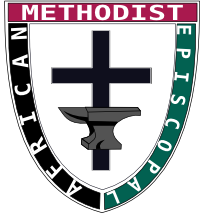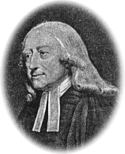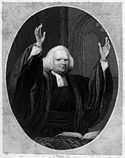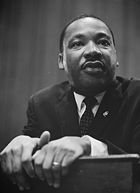African Methodist Episcopal Church
| African Methodist Episcopal Church | |
|---|---|
 God Our Father, Christ Our Redeemer, Man Our Brother |
|
| Classification | Protestant |
| Orientation | Methodist |
| Polity | Episcopal |
| Associations | National Council of Churches; World Council of Churches; Churches Uniting in Christ |
| Development | |
| Founder | Richard Allen |
| Origin | 1816 Philadelphia, Pennsylvania |
| Separated from | Methodist Episcopal Church |
| Statistics | |
| Congregations | 7,000 |
| Members | 5 million (2.5 million in the United States) |
The African Methodist Episcopal Church, usually called the "AME Church", is a Christian denomination founded by Bishop Richard Allen in Philadelphia, Pennsylvania, in 1816.
Contents |
Church name
- African: The AME church was organized by people of African descent. The church was not founded in Africa, nor is it only for persons of African descent. The church is open to people of all races.
- Methodist: The church's roots are in the Methodist church. Members of St. George's Methodist Church left the congregation when faced with racial discrimination, but continued with the Methodist doctrine and the order of worship.
- Episcopal: The AME church operates under an episcopal form of church government. The denomination leaders are Bishops of the church. Episcopal, in this sense, refers to the form of government under which the church operates.[1]
Motto
"God Our Father, Christ Our Redeemer, Holy Spirit Our Comforter, Humankind Our Family"
Derived from Bishop Daniel Payne (1811-1893).
| Part of a series on Methodism |
|
 |
 |
| John Wesley | George Whitefield |
|
Background |
Doctrinal distinctives |
|
People |
Largest groups |
|
Related movements Holiness movement |
|
This Do in Remembrance Of Me
History
The African Methodist Episcopal Church has a unique history in that it is the first major religious denomination in the Western World that had its origin over sociological rather than theological beliefs and differences, and the first African-American organized and incorporated denomination in the US. The AME church is also the church that sponsored the first independent historical black college, Wilberforce University. The church was born in protest against slavery—against dehumanization of African people, brought to the American continent as free labor. This fit well with the Methodist church's philosophy since its founder John Wesley had once called the slave-trade "that execrable sum of all villanies".
The AMEC grew out of the Free African Society (FAS) which Richard Allen, Absalom Jones, and others established in Philadelphia in 1787. The church was organized by African-American members of St. George's Methodist Episcopal Church. The incident that led to this was the removal of Absalom Jones (1746–1818) from St. George's by the trustees while he was in the act of prayer. The congregation supported the act of the trustees, and Allen and Jones led the African-American members out of St. George's as a body. Allen went on to form the Bethel African Methodist Episcopal Church in 1793. In general, they adopted the doctrines and form of government of the Methodist Episcopal Church. Jones affiliated with the Protestant Episcopal Church and would go on to become the first African-American priest in the Episcopal Church.
When officials at St. George’s MEC pulled blacks off their knees while praying, FAS members discovered just how far American Methodists would go to enforce racial discrimination against African Americans. Hence, these members of St. George’s made plans to transform their mutual aid society into an African congregation. Although most wanted to affiliate with the Protestant Episcopal Church, Allen led a small group who resolved to remain Methodists. In 1794 Bethel AME was dedicated with Allen as pastor. To establish Bethel’s independence from interfering white Methodists, Allen, a former Delaware slave, successfully sued in the Pennsylvania courts in 1807 and 1815 for the right of his congregation to exist as an independent institution. Because black Methodists in other middle Atlantic communities encountered racism and desired religious autonomy, Allen called them to meet in Philadelphia to form a new Wesleyan denomination, the AME.
While the AME is doctrinally Methodist, clergy, scholars, and lay persons have written important works which demonstrate the distinctive theology and praxis which have defined this Wesleyan body. Bishop Benjamin W. Arnett, in an address to the 1893 World’s Parliament of Religions, reminded the audience of the presence of blacks in the formation of Christianity. Bishop Benjamin T. Tanner wrote in 1895 in The Color of Solomon – What? that biblical scholars wrongly portrayed the son of David as a white man. In the post civil rights era theologians James Cone, Cecil W. Cone, and Jacqueline Grant who came out of the AME tradition critiqued Euro-centric Christianity and African American churches for their shortcomings in fully impacting the plight of those oppressed by racism, sexism, and economic disadvantage.
Beliefs
The AME Motto, "God Our Father, Christ Our Redeemer, Holy Spirit Our Comforter, Humankind Our Family", reflects the basic beliefs of the African Methodist Episcopal Church.
The basic foundations of the beliefs of the church can be summarized in The Apostles' Creed and The Twenty Five Articles of Religion.
Church mission
The Mission of the African Methodist Episcopal Church is to minister to the spiritual, intellectual, physical, emotional, and environmental needs of all people by spreading Christ's liberating gospel through word and deed. At every level of the Connection and in every local church, the African Methodist Episcopal Church shall engage in carrying out the spirit of the original Free African Society, out of which the A.M.E. Church evolved: that is, to seek out and save the lost, and serve the needy through a continuing program of (1) preaching the gospel, (2) feeding the hungry, (3) clothing the naked, (4) housing the homeless, (5) cheering the fallen, (6) providing jobs for the jobless, (7) administering to the needs of those in prisons, hospitals, nursing homes, asylums and mental institutions, senior citizens' homes; caring for the sick, the shut-in, the mentally and socially disturbed, and (8) encouraging thrift and economic advancement.[2]
Colleges, seminaries and universities
The African Methodist Episcopal Church has been one of the forerunners of education within the African-American Community.
Former Colleges & Universities of the AME Church
- Campbell College (Jackson, MS)
- Daniel Payne College (Birmingham, AL)
- Kittrell College (Kittrell, NC)
- Western University (Kansas)
Senior Colleges within the United States
- Allen University (Columbia, SC) Website
- Edward Waters College (Jacksonville, FL) Website
- Morris Brown College (Atlanta, GA) Website
- Paul Quinn College (Dallas, TX) Website
- Wilberforce University (Wilberforce, OH) Website
Junior Colleges within the United States
- Shorter College (North Little Rock, AR) Website
Theological Seminaries within the United States
- Jackson Theological Seminary Website
- Payne Theological Seminary Website
- Turner Theological Seminary Website
Structure
The General Conference
The General Conference is the supreme body of the African Methodist Episcopal Church. It is composed of the Bishops, as ex-officio presidents, according to the rank of election, and an equal number of ministerial and lay delegates, elected by each of the Annual Conferences and the lay Electoral Colleges of the Annual Conferences. Other ex-officio members are: the General Officers, College Presidents, Deans of Theological Seminaries; Chaplains in the Regular Armed Forces of the U.S.A. The General Conference meets quadrennially (every four years), but may have extra sessions in certain emergencies.
Council of Bishops
The Council of Bishops is the Executive Branch of the Connectional Church. It has the general oversight of the Church during the interim between General Conferences. The Council of Bishops shall meet annually at such time and place as the majority of the Council shall determine and also at such other times as may be deemed necessary in the discharging its responsibility as the Executive Branch of the African Methodist Episcopal Church. The Council of Bishops shall hold at least two public sessions at each annual meeting. At the first, complaints and petitions against a Bishop shall be heard, at the second, the decisions of the Council shall be made public. All decisions shall be in writing.
Board of Incorporators
The Board of Incorporators, also known as the General Board of Trustees, has the supervision, in trust, of all connectional property of the Church and is vested with authority to act in behalf of the Connectional Church wherever necessary.
The General Board
The General Board is in many respects the administrative body and comprises various departmental Commissions made up of the respective Secretary-Treasurer, the General Secretary of the A.M.E,. Church the General Treasurer and the members of the various Commissions and one Bishop as presiding officer with the other Bishops associating.
Judicial Council
The Judicial Council is the highest judicatory body of the African Methodist Episcopal Church. It is an appellate court, elected by the General Conference and is amenable to it.
Overview
The AME church estimates around 5,000,000 members worldwide (2.5 million in America), 9000 ministers, and 7000 congregations in more than 30 nations in North and South America, Africa, and Europe. Twenty bishops and 12 general officers lead the denomination.
The AME Church is a member of the National Council of Churches of Christ in the USA (NCC), and the World Council of Churches.
It is not the same as the U.A.M.E. Church founded in Delaware by Peter Spencer in 1813, or the AME Zion Church, founded in New York by James Varick.
Bishops (Past and Present)
Four Prominent Bishops
- Richard Allen, founder and first bishop (1816-1841)
- William Paul Quinn, fourth bishop (1849-1873)
- Daniel Payne, sixth bishop (1811-1893)
- Henry McNeal Turner, twelfth bishop (1834-1915)
Active Bishops (in order of current episcopal district)
- Richard Franklin Norris
- Adam Jefferson Richardson, Jr.
- Cornal Garnett Henning, Sr.
- John Richard Bryant
- Theodore Larry Kirkland
- William Phillips DeVeaux, Sr.
- Preston Warren Williams, II
- Carolyn Tyler Guidry
- James Levert Davis
- Gregory Gerald McKinley Ingram
- McKinley Young
- Samuel Lawrence Green, Sr.
- Vashti Murphy McKenzie
- David Rwhynica Daniels, Jr.
- Wilfred Messiah
- Sarah Frances Davis
- Paul Jones Kawimbe
- E. Earl McCloud, Jr.
- Jeffrey N. Leath
- Julius H. McAlister, Sr.
- John F. White, Sr. Office of Ecumenical Affairs
Active General Officers (2004 - 2008)
- Dennis C. Dickerson, Historiographer/Executive - Director, Department of Research and Scholarship.
- Richard Allen Lewis, Treasurer/CFO AMEC Finance Department.
- Clement W. Fugh, General Secretary/CIO
- Johnny Barbour, Jr., Secretary Treasurer, Sunday School Union
- George F. Flowers, Secretary-Treasurer, Department of Missions (Global Witness Ministry)
- Jerome V. Harris, Executive Director, Department of Annuity Investments and Insurance
- James C. Wade, Executive Director, Department of Church Growth and Development
- Daryl B. Ingram, Secretary-Treasurer, Department of Christian Education
- Calvin H. Sydnor III, the 20th Editor, The Christian Recorder, The Official Newspaper of the AME Church [www.the-christian-recorder.org ].
Retired General officers
- Sherman L. Green, Jr.
- John W. P. Collier, Jr.
- Henderson S. Davis (Deceased)
- Jamye Coleman Williams
- Joseph McKinney (Deceased)
- Robert H. Reid, Jr.
- A. W. Holman (Deceased)
- A. Lee Henderson (Deceased)
- Cecil W. Howard (Deceased)
- Anderson Todd
- Paulette Coleman
- Kenneth H. Hill
- George L. Champion, Sr. (Deceased)
- Ricky Spain
Notable AME ministers and educators
- Bishop William Heard (1850-1937), AME minister and educator. Appointed by the U.S. government as "Minister Resident/Consul General" to Liberia (1895-1898)[1]
- Bishop Daniel Payne (1811-1893), historian, educator and AME minister. First African-American president of an African-American university, Wilberforce University, in the U.S. [2]
- Dr. Jamye Coleman Williams (1918 -), educator, community leader. Former editor of the AME Church Review; recipient of the NAACP Presidential Award (1999).[3]
- Bishop Vashti Murphy McKenzie, first female AME bishop in church history, best-selling author.
- Bishop Carolyn Tyler Guidry (1937- ), second female AME bishop in church history. [4]
- Rev. Dr. Floyd H. Flake (1945- ), former U.S. Congressman from New York (1986-1998); senior pastor of 23,000 member Allen AME Church in Jamaica, Queens, New York; President of Wilberforce University, Ohio.
- Rev. Dr. Frank M. Reid III (1951-) Pastor of the 19,000 member Bethel A.M.E. Church in Baltimorelink title. Rev. Reid started "The Bethel Outreach of Love" Broadcast was the first African Methodist Episcopal Church to have an international TV broadcast. He is a well noted author. Was selected as the 26th most influential person in Baltimore by Baltimore Magazine. His membership includes the mayor and city comptroller of Baltimore. He was also a consultant for the T.V. show Amen, and guest starred several times on the popular HBO series The Wire.
- Rev. Dr. Jamal-Harrison Bryant is the founder and Pastor of the fastest growing AME Church in the nation Empowerment Temple AME [5] in Baltimore, and a popular author and speaker throughout North America. Speaking on such programs as TBN, including his own national television program.
- Rev. Henry Aaron Joubert (1940 - 2004) leader par execellence of Cape Town South Africa, administrator builder and respected leader in the community in which he resided. Respected by all Bishops he served under and rendered untiring service in adverse situations in South Africa.
- Rev. Dr. Norvel Goff, Sr. (1949 -) Key figure involved in the development of the Kodak External Advisory Panel on Diversity and the disperspement of over $13 million in restitution checks and salary increases, and promoted many black employees at the company. Former Majority Leader of the Hartford, CT City Council; he has been an adviser on diversity issues to CEO's from numerous corporations.
- General Officer, Dr. Dennis C. Dickerson, Historiographer/Executive - Director, Department of Research and Development.
- General Officer, Dr. Richard Allen Lewis, Treasurer/CFO AMEC Finance Department.
- General Officer, Dr. Clement W. Fugh, General Secretary/CIO
- General Officer, Dr. Johnny Barbour, Jr., Secretary Treasurer, Sunday School Union
- General Officer, Dr. George F. Flowers, Secretary-Treasurer, Department of Missions (Global Witness Ministry)
- General Officer, Dr. Jerome V. Harris, Executive Director, Department of Annuity Investments and Insurance.
- General Officer, Dr. James C. Wade, Executive Director, Department of Church Growth and Development.
- General Officer, Dr. Daryl B. Ingram, Secretary-Treasurer, Department of Christian Education
- General Officer, Dr. Calvin H. Sydnor III, the 20th Editor, The Christian Recorder, The Official Newspaper of the AME Church[www.the-christian-recorder.org ].
Notable AME Members
- Vernon Jordan
- Carolyn Cheeks Kilpatrick US Representative (D-MI)
- Brandon Karl Allen
- Byron Cage
- James E. Clyburn US Representative (D-SC)
- LL Cool J
- Sheila Dixon, Mayor of Baltimore, Maryland
- Arsenio Hall
- Gwen Ifill
- John Legend
- Ray Lewis
- Dr. Susan McKinney Stewart
- Gregory Meeks, US Representative (D-NY)
- Delroy Lindo
- Rosa Parks
- Hiram Rhodes Revels, First African-American Senator
- Cicely Tyson
- Billy Dee Williams
- Stephanie Diana Wilson
- Dave Winfield
See also
- Black church
- Churches Uniting in Christ
- Methodism
- List of African Methodist Episcopal Churches
- Category:African Methodist Episcopal bishops
- Category:Universities and colleges affiliated with the African Methodist Episcopal Church
External links
- Official website of the AME Church
- AME Today News
- AME Today Discussion Forum
- Women's Missionary Society of the AME church
- AMEC Office of Employment Security
- AME Church Storehouse
- AME Church Department of Global Witness & Ministry
- The AMEC Christian Recorder
- AMEC Department of Christian Education
- The AMEC Lay Organization
- Richard Allen Young Adult Council
- Charleston SC's Emanuel AME Church - Article about Charleston's historic Emanuel AME Church
Select district websites
- First Episcopal District of the AMEC - Bermuda, New Jersey, Delaware, New York, New England and Philadelphia
- Second Episcopal District of the AMEC - Baltimore, Washington, D.C., Virginia, North Carolina
- Third Episcopal District of the AMEC - Ohio, Pittsburgh, West Virginia
- Fourth Episcopal District of the AMEC - Indiana, Chicago, Illinois, Michigan, Canada
- Fifth Episcopal District of the AMEC - Missouri, Kansas-Nebraska, Colorado, California, Pacific Northwest
- Sixth Episcopal District of the AMEC - Georgia
- Seventh Episcopal District of the AMEC - South Carolina
- Eighth Episcopal District of the AMEC - Louisiana, Mississippi
- Tenth Episcopal District of the AMEC - Texas
- Eleventh Episcopal District of the AMEC - Florida, Bahamas
- Twelfth Episcopal District of the AMEC - Oklahoma, Arkansas
- Thirteenth Episcopal District of the AMEC - Tennessee, Kentucky
- Fifteenth Episcopal District of the AMEC - Western Cape, Namibia, Kalahari, Eastern Cape, Angola and Queenstown
- Sixteenth Episcopal District of the AMEC - Guyana-Suriname, Windward Islands, Virgin Islands, Dominican Republic, Haiti, Jamaica, Cuba and London
- Eighteenth Episcopal District of the AMEC - Lesotho, Swaziland, Botswana, Mozambique
- Twentieth District of the AMEC - Zimbabwe, Malawi, Tanzania, Uganda
Other districts and their jurisdictions
- Ninth Episcopal District of the AMEC - Alabama
- Fourteenth Episcopal District of the AMEC - Liberia, Sierra Leone, Ghana, Nigeria, Cote d'Ivoire and Togo-Benin
- Seventeenth Episcopal District of the AMEC - Southeast Zimbabwe - Zambia, Democratic Republic of the Congo, Rwanda, Burundi, Republic of the Congo
- Nineteenth Episcopal District of the AMEC - KwaZulu-Natal, Gauteng, Limpopo, Mpumalanga, Free State
References
- Encyclopedia of Religion in the South, Samuel S. Hill, editor
- The Doctrine and Discipline of the African Methodist Episcopal Church 2000
- The AMEC Book of Worship
- History of the AME Church: The Black Church in Action, Howard D. Gregg, Ph.D.
- See "God Our Father, Christ Our Redeemer, Man Our Brother: A Theological Interpretation of the AME Church." By Dr. James H. Cone, Ph.D. AME Church Review, Volume CVI, No. 341 (1991), page 25.
Notes
- ↑ AME Church homepage describing its name
- ↑ The Doctrine and Discipline of the African Methodist Episcopal Church. (2000). p. 13.
|
|||||||||||||
